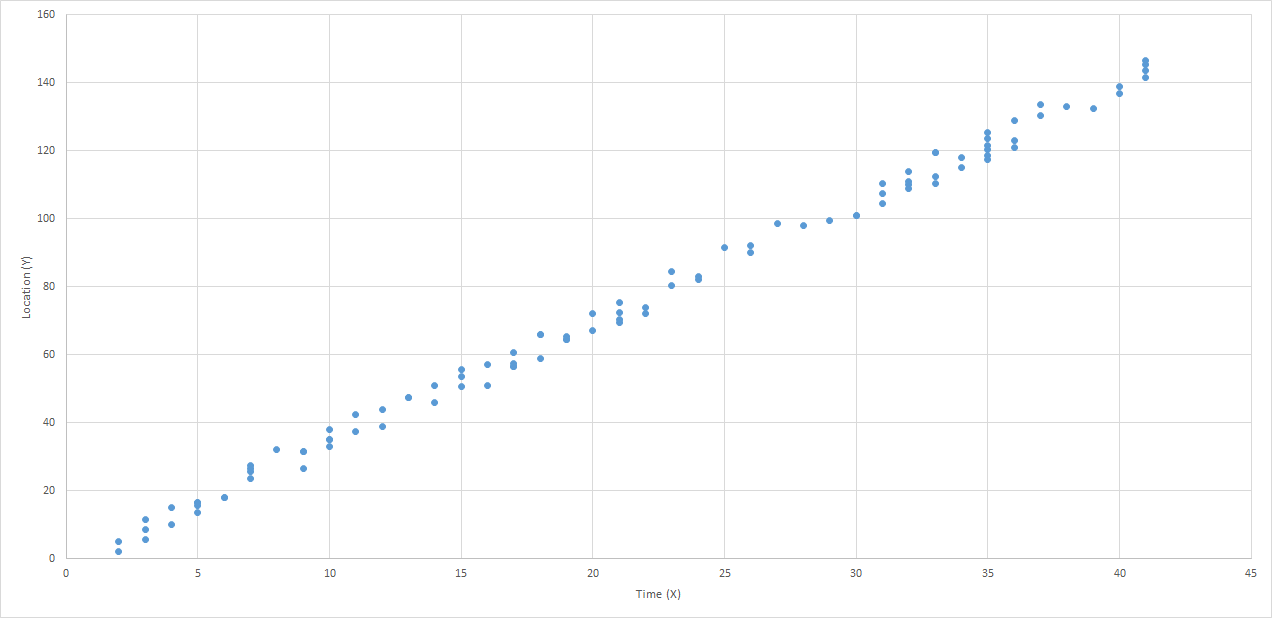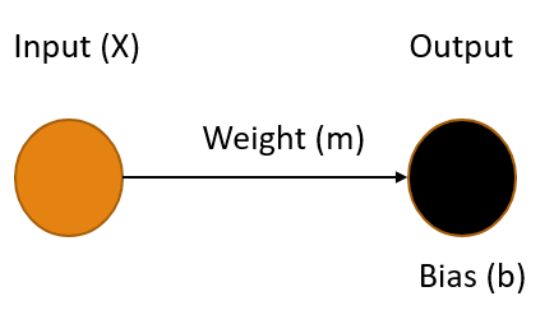Tag: ml
Simple Linear Regression
Posted by bsstahl on 2023-02-13 and Filed Under: development
My high-school chemistry teacher, Mrs. J, had a name for that moment when she could see the lightbulb go on over your head. You know, that instant where realization hits and a concept sinks-in and becomes part of your consciousness. The moment that you truly "Grok" a principle. She called that an "aha experience".
One of my favorite "aha experiences" from my many years as a Software Engineer, is when I realized that the simplest neural network, a model with one input and one output, was simply modeling a line, and that training such a model, was just performing a linear regression. Mind. Blown.
In case you haven't had this particular epiphany yet, allow me to go into some detail. I also discuss this in my conference talk, A Developer's Introduction to Artificial Intelligences.
Use Case: Predict the Location of a Train
Let's use the example of predicting the location of a train. Because they are on rails, trains move in 1-dimensional space. We can get a good approximation of their movement, especially between stops, by assuming they travel at a consistent speed. As a result, we can make a reasonably accurate prediction of a train's distance from a particular point on the rail, using a linear equation.
If we have sensors reporting the location and time of detection of our train, spread-out across our fictional rail system, we might be able to build a graph of these reports that looks something like this:

I think it is clear that this data can be represented using a "best-fit line". Certainly there is some error in the model, perhaps due to sensor or reporting errors, or maybe just to normal variance of the data. However, there can be no doubt that the best fit for this data would be represented as a line. In fact, there are a number of tools that can make it very easy to generate such a line. But what does that line really represent? To be a "best-fit", the line needs to be drawn in such a way as to minimize the differences between the values found in the data and the values on the line. Thus, the total error between the values predicted by our best-fit line, and the actual values that we measured, is as small as we can possibly get it.
A Linear Neural Network
A simple neural network, one without any hidden layers, consists of one or more input nodes, connected with edges to one or more output nodes. Each of the edges has a weight and each output node has a bias. The values of the output nodes are calculated by summing the product of each input connected to it, along with its corresponding weight, and adding in the output node's bias. Let's see what our railroad model might look like using a simple neural network.

Ours is the simplest possible neural network, one input connected to one output, where our X value (time) is the input and the output Y is our prediction of the distance the train has traveled in that time. To make the best prediction we need to determine the values for the weight of the edge m and the bias of the output node b that produce the output that minimizes the errors in the model.
The process of finding the weights and biases values for a neural network that minimize the error is know as Training the model. Once these values are determined, we use the fact that we multiply the weight by the input (m * X) and add in the bias. This gives us an equation in the form:
Y = mX + b
You may recognize this as the slope-intercept form of the equation for a line, where the slope m represents the speed of the train, and the bias b represents the starting distance from the origin. Once our training process gives us values for m and b, we can easily plug-in any value for X and get a prediction for the location of our train.
Training a Model
Training an AI model is simply finding the set of parameters that minimize the difference between the predicted output and the actual output. This is key to understanding AI - it's all about minimizing the error. Error minimization is the exact same goal as we have when performing a linear regression, which makes sense since these regressions are predictive models on their own, they just aren't generally depicted as neural networks.
There are many ways to perform the error-minimization process. Many more complicated models are trained using an iterative optimization routine called Gradient Descent. Extremely simple models like this one often use a less complicated process such as Ordinary Least Squares. The goals are the same however, values for weights and biases in the model are found that minimize the error in the output, resulting in a model can make the desired predictions based on known inputs.
Regardless of the method used, the realization that training the simplest neural network results in a model of a line provided the "aha experience" I needed as the foundation for my understanding of Machine Learning models. I hope, by publishing this article, that others may also benefit from this recognition.
Tags: ai algorithms ml optimization presentation
Troubleshooting Information for Machinelearning-ModelBuilder Issue #1027
Posted by bsstahl on 2021-04-03 and Filed Under: tools
Update: The issue has been resolved. There was an old version of the Extension installed on failing systems that was causing problems with Visual Studio Extensions. Even though the version of the Extension showed as the correct one, an old version was being used. A reinstall of Visual Studio was needed to fix the problem.
There appears to be a problem with the Preview version of the ModelBuilder tool for Visual Studio. This issue has been logged on GitHub and I am documenting my findings here in the hope that they will provide some insight into the problem. I will update this post when a solution or workaround is found.
I want to be clear that this problem is in a preview version, where problems like this are expected. I don't want the team working on this tooling to think that I am being reproachful of their work in any way. In fact, I want to compliment them and thank them for what is generally an extremely valuable tool.
To reproduce this problem, use this Data File to train an Issue Classification or Text Classification model in the ModelBuilder tool by using the Key column to predict the Value column. The keys have intelligence built into them that are valid predictors of the Value (I didn't design this stuff).
Machines that are unable to complete this task get a error stating Specified label column 'Value' was not found. with a stack trace similar to this.
This process seems to work fine on some machines and not on others. I have a machine that it works on, and one that it fails on, so I will attempt to document the differences here.
The first thing I noticed is that the experience within the tool is VERY DIFFERENT even though it is using the exact same version of the Model Builder.
From the machine that is able to train the model

From the machine having the failure

Everything seems to be different. The headline text, the options that can be chosen, and the graphics (or lack thereof). My first reaction when I saw this was to double-check that both machines are actually using the same version of the Model Builder tool.
Verifying the Version of the Tool
Spoiler alert: To the best I am able to verify, both machines are using the same version of the tool.
From the machine that is able to train the model

From the machine having the failure

My next thought is that I'm not looking at the right thing. Perhaps, ML.NET Model Builder (Preview) is not the correct Extension, or maybe the UI for this Extension is loaded separately from the Extension. I can't be sure, but I can't find anything that suggests this is really the case. Perhaps the dev team can give me some insight here.
Verifying the Region Settings of the Machine
While these versions are clearly the same, it is obvious from the graphics that the machines have different default date formats. Even though there are no dates in this data file, and both machines were using US English, I changed the Region settings of the problem machine to match that of the functional machine. Predictably, this didn't solve the problem.
From the machine that is able to train the model

From the machine having the failure - Original Settings

From the machine having the failure - Updated Settings

Checking the Versions of Visual Studio
The biggest difference between the two machines that I can think of, now that the region settings match, is the exact version & configuration of Visual Studio. Both machines have Visual Studio Enterprise 2019 Preview versions, but the working machine has version 16.9.0 Preview 1.0 while the failing machine uses version 16.10.0 Preview 1.0. You'll have to forgive me for not wanting to "upgrade" my working machine to the latest preview of Visual Studio, just in case that actually is the problem, though I suspect that is not the issue.
From the machine that is able to train the model

From the machine having the failure

There are also differences in the installed payloads within Visual Studio between the 2 machines. Files containing information about the installations on each of the machines can be found below. These are the files produced when you click the Copy Info button from the Visual Studio About dialog.
From the machine that is able to train the model
Visual Studio Payloads - Functional Machine
From the machine having the failure
Visual Studio Payloads - Problem Machine
Windows Version
Another set of differences involve the machines themselves and the versions of Windows they are running. Both machines are running Windows 10, but the working machine runs a Pro sku, while the problem machine uses an Enterprise sku. Additionally, the machines have different specs, though they are consistent in that they are both underpowered for what I do. I'm going to have to remedy that.
I've included some of the key information about the machines and their OS installations in the files below. None of it seems particularly probative to me.
From the machine that is able to train the model
System and OS - Functional Machine
From the machine having the failure
System and OS - Problem Machine
Other Things to Check
There are probably quite a number of additional differences I could look at between the 2 machines. Do you have any ideas about what else I could check to give the dev team the tools they need to solve this problem?